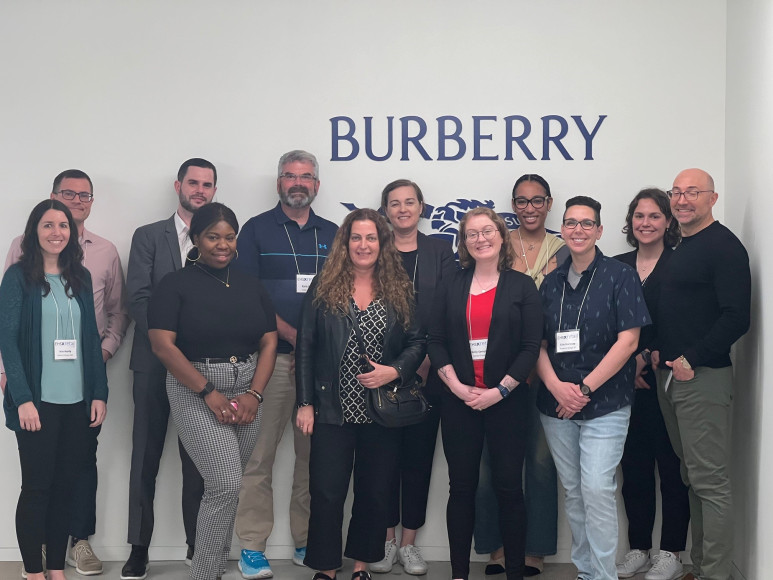Antea Group recently facilitated our annual EHSxRetail event hosted by Burberry at their new New York City office. This is a peer-to-peer roundtable that allows environment, health, safety, and sustainability (EHS&S) professionals in the retail industry to gather with peers to discuss current trends that impact their operations, challenges, share success stories and best practices, and more.
The main topics of discussion this year included workplace violence and other emerging regulations, the importance of cross-functional teams for the successful implementation of EHS, and mental health in retail.
The discussions were facilitated by Kelly Sampliner, CSP (Retail Industry Leader), Lauren Corbett-Noon (EHS Auditing and Compliance Leader), Colleen Brents, PhD, AEP (Wellness Expert), and Jessica Hardy (Retail Industry Expert). The following sections provide an overview of the discussions that took place at EHSxRetail this year:
Workplace Violence
One of the most prevalent topics that has been on the minds of many EHS professionals is workplace violence. Workplace violence is especially concerning for retailers given they are interfacing with the public. On July 1, 2024, California will require businesses and employers in the state to develop a written workplace violence prevention plan (WVPP) and demonstrate that the plan is implemented and that all employees have been provided with associated training.
There has been a significant increase in shoplifting and organized retail crime, greatly impacting retailers across the board. However, retailers have a lot more to worry about than just profit losses. Many retailers now fear for their employees’ safety, with 88% of retailers reporting that shoplifters are more aggressive and violent compared with a year ago.
As EHS professionals, it can be stressful and difficult to know what to do to keep your workers and customers safe when workplace violence is on the rise. Mental health is an essential component to preventing workplace violence.
Retail EHS leaders are encouraged to define roles and responsibilities related to workplace violence. Many retailers are working closely with their security teams to implement WVPPs. We’ll discuss the importance of cross-functional teams in the next section.
Once you define the team responsible for implementing the WVPP, check in with the implementation team, as working closely with workplace violence-related matters can eventually take a toll on mental health.
Mental health first aid training, training that teaches workers to identify, understand, and respond to signs of mental illness and substance abuse, is becoming more relevant in the retail industry, and is something retailers have been adding to their list of support resources. De-escalation is another important tactic for retail workers to utilize while interacting with the public. Training workers on how to de-escalate certain situations can empower them to feel more confident in their daily job, and it gives them methods for interacting with the public.
However, workplace violence training shouldn’t only apply to public-facing employees. In reality, it takes a team. That includes getting Human Resources (HR), Business Partners, security teams, etc., on the same page to plan and implement WVPPs in your workplace. What works for one retailer may not work for another – but the key is including various roles in the development and implementation of these plans to pool together the organization’s perspectives and expertise in combating one of retail’s biggest challenges.
Mental health in retail
Did you know that 1 in 5 retail workers plan to quit the industry? Due to increased workplace violence from shoplifting and organized retail crime, retail employees are facing a significant amount of stress, anxiety, and other mental health issues, especially when they are in public facing positions.
Employees who don’t feel safe at work are likely suffering from increased stress and anxiety, which can lead to burnout. One of the best things an EHS team can do to help alleviate this is to regularly check in with employees and make sure they feel supported not just from a safety perspective, but for mental health as well.
A great place to start is by assessing the culture and obtaining a baseline of how employees feel about a certain topic, such as safety, wellness, etc. This could include completing a culture survey to assess and measure beliefs, values, operations, perceptions, and overall culture at your organization. This initial survey can act as your baseline, providing valuable information about what employees are thinking and feeling and what they believe, which directly ties to how they behave. Then, trends can be monitored over time if subsequent surveys are deployed.
The best organizations realize that employee engagement is the key to success. Taking the temperature of your organization allows you to understand how employees feel about current policies and procedures, and in turn, it gives employees an opportunity to open up and share their recommendations for improvement.
Once you establish this baseline, checking in is key to promoting wellness. May is Mental Health Awareness Month, which makes it a particularly good time to check in on your retail workers. Retail comes with high stress, burnout, and high turnover. Asking your employees questions about how they’re feeling can go a long way to promoting connection and trust.
There is a great amount of overlap between EHS and wellness, and the more you invest in worker wellness, the more job retention and satisfaction will increase. It’s also important to identify which department takes ownership of wellness. Oftentimes, that could include an overlap between EHS teams, Facilities, HR, and other teams as needed.
The Importance of Cross-Functional Teams for EHS
As mentioned above, it takes more than one team to handle EHS at your workplace, especially when it comes to workplace violence training and plan implementation. Utilizing a cross-functional committee to bring all the teams together is key to successfully implementing an EHS program.
When it comes to EHS, it’s too much for one person to handle. Without a cross-functional team, silos can pop up in your organization, which can lead to a lack of communication between teams. It’s important for teams to hear each other and come to an understanding instead of operating on their own.
Additionally, utilizing a cross-functional team to get input from all teams on EHS topics can help bring together different, but necessary perspectives. For example, HR might have one view of how to implement a WVPP, but that view could differ from the team that is public facing every day, or your security team. Working together eliminates silos, offers unique solutions to challenges, fosters a more positive work environment, and results in your teams being stronger together.
Key Takeaways
The event provided invaluable insights into the pressing issues facing the retail industry today. By prioritizing safety, leveraging cross-functional teams, and promoting mental health, retailers can build a resilient and thriving workforce prepared to face the challenges of today and tomorrow.
Learn more about EHSxRetail and stay tuned for future events here!
Visit our retail page to learn more our EHS services and check out the interactive graphic below to learn about more common health and safety hazards and how you can address them:
Learn More About Our Retail ServicesHave any questions?
Contact us to discuss your environment, health, safety, and sustainability needs today.





